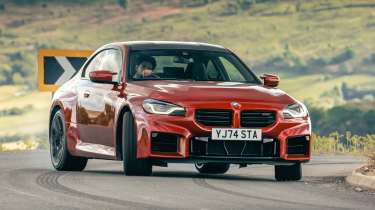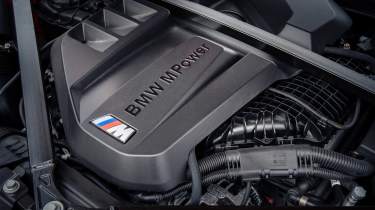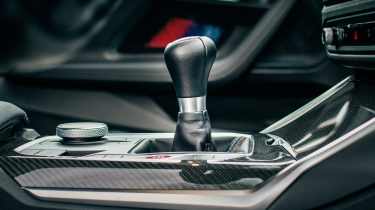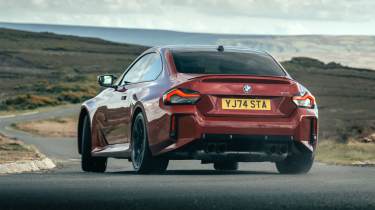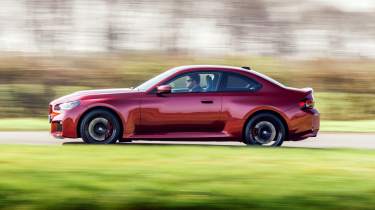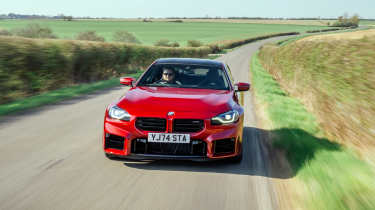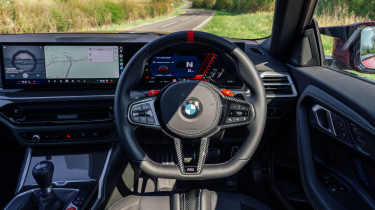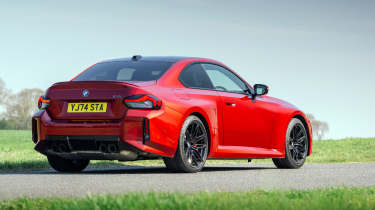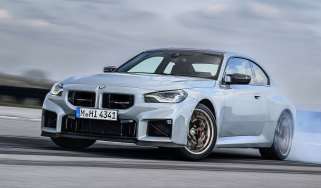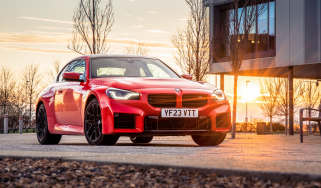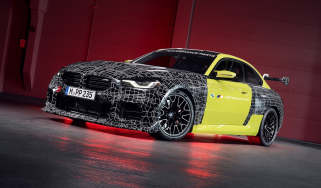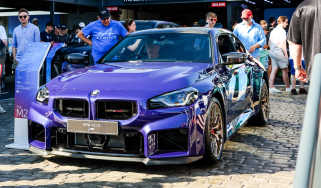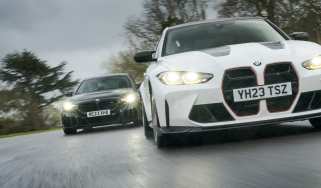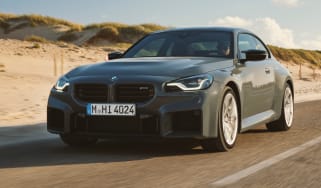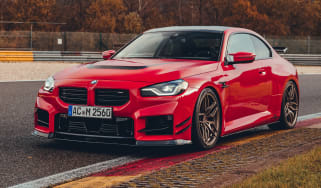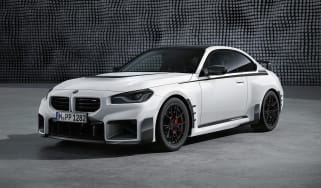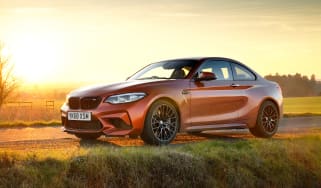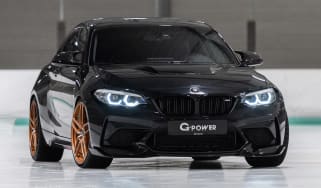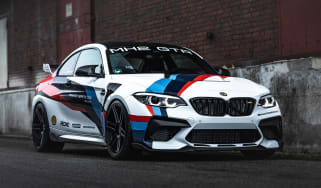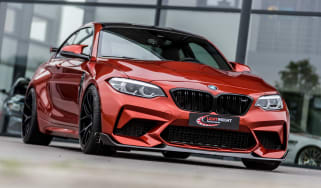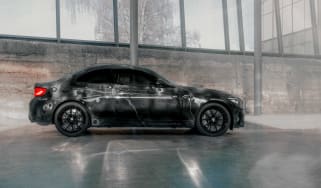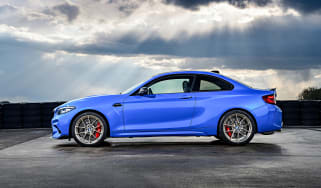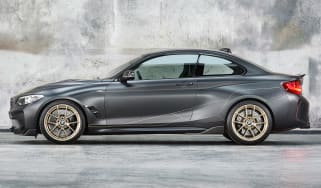BMW M2 2025 review – a fun, full-fat M car but no match for a Cayman
The M2 has evolved into a near-500bhp powerhouse of a coupe, and still comes with three pedals. It’s a barrel of laughs, if not as deft and rewarding as a bespoke sports car
evo verdict
The latest M2 is part of a dying breed of traditional front-engined manual coupes. As such there isn’t much direct competition to judge it against, which moves it into the firing line of more bespoke two-seat sports cars like the Porsche Cayman, Lotus Emira and Alpine A110. It’s not as special or rewarding as any of those, but the M2 fights back by being genuinely usable day-to-day and having a wild, playful side that reveals itself at will. It lacks the tactility and connection of the very best M cars, but it’s still a sharp, capable and entertaining brute of a coupe.
Background
If the G87 BMW M2 were to follow the release trajectory of its predecessor, the F87 M2, right about now we’d be getting a more focused, more powerful M2 Competition. As it transpires, no such model is arriving with the updated (LCI, in BMW speak) 2025 BMW M2. But the new car does arrive with a bump in power and detail revisions inside and out, as we await the arrival of the ultimate G87 M2 iteration, the incoming M2 CS.
Amongst the noise around the new M5 and high-riding behemoths like the XM, the M2 remains a reminder that BMW M is still more than capable of delivering on the classic sports coupe recipe it created with the E30 M3.
More reviews
Group tests
Long term tests
Reviews
- BMW M235 xDrive Gran Coupe 2025 review – Audi S3 saloon fighter isn’t a full-on M car
- Used BMW M235i and M240i Coupe (F22, 2014 - 2021): review and specs for BMW’s junior M car
- Used BMW M2 Competition (F87, 2018 - 2020) review – modern M car great for hot hatch money
- BMW 230i 2025 review – a BMW coupe of the old school?
- Litchfield BMW M2 2024 review: 640bhp tuned M2 tested
Based on a shortened M4 platform means it’s broader and heavier than its precedessor, but it still retains a relatively compact body, a gutsy six-cylinder engine, rear-wheel drive with the option of a manual gearbox. The M2 is still therefore, about as traditional as modern M cars get. Based on the brilliant M4 but with 110mm chopped out of the wheelbase, less weight and bespoke chassis tuning, the M2 recipe is a tantalising one, promising ‘big engine, small car’ character that made its ancestor, the charismatic 1M, so irresistible.
We’ve tested the M2 extensively on road and track to discover whether it lives up to its brilliant predecessors – as well as rivals from Porsche, Alpine and Mercedes-AMG. We’ve also now spent a few hundred miles in the updated, more powerful G87 M2, to see if it still does the business.
Engine, gearbox and technical highlights
- Upgraded chassis hardware on a shortened M4 platform
- Updates boost straight-six from 454bhp to 473bhp
- Eight-speed automatic or six-speed three pedal option
The M2 is built on a shortened variation of the current 4-series platform, with the same track width and suspension architecture as the M3 and M4 and S58 3-litre twin-turbo straight-six engine.
In the M3 and M4 Competition, it’s had a bump in power to produce 523bhp (at 6250rpm), up 20bhp from before, with the same 479lb ft torque figure that sticks around for 230rpm longer (between 2750 and 5730rpm). The 2025 M2 gets a similar boost, to a not-exactly-paltry 473bhp (at 6250rpm) and 406lb ft, which also hangs around for longer in the rev range (between 2650 until 6130rpm). That torque figure rises to 443lb ft in the automatic car.
The auto is an eight-speed ZF torque-convertor that’s fitted as standard, with the six-speed manual lingering on as an option in the UK (albeit for a cheeky £1925). The auto is, predictably, the quicker of the two, cracking the 62mph sprint in 4sec, a couple of tenths quicker than the manual. The top speed is limited to 155mph, but can be raised a smidge to 160mph with the optional M Driver’s Pack.
With a wheelbase shortened by 110mm, the M2 is a sawn-off shottie version of an M4, but still a touch longer than the previous F87 M2 (it’s a smidge larger in every dimension). The optional carbonfibre roof lops 6kg off the kerb weight, although it’s still relatively porky for a small, two-wheel-drive car, however, quoted at 1705kg with the manual gearbox and 1730kg if you stick with the auto.
Adaptive dampers are standard and evolved from the units fitted to the M3 Touring. These work with stiffer front and softer rear spring rates than the M3/4 to account for the M2’s shorter wheelbase, difference in kerb weight and weight distribution, along with bigger 19-inch front and 20-inch rear wheels than the F87 M2. Optional Michelin Pilot Sport Cup 2 tyres improve on the M2’s track credentials, and torque is transferred to the rear wheels alone via an electronically-controlled limited-slip diff. Michelin’s Pilot Sport 4 S tyres are the standard fit.
Driver’s note
‘Although the manual shift (a £1925 option) is not the most tactile in the world, and annoyingly the optional bucket seats’ carbon leg divider catches your leg as you press the clutch pedal, it does bring an extra layer of interactivity. You’re more inclined to stay in one gear for longer, feeling the engine at work at different stages of its rev range.’ – James Taylor, evo deputy editor, who tested the BMW M2 on the launch and on the road in the UK.
Performance, ride and handling
- Supreme performance and flexibility
- From calm and subdued to wildly playful with the touch of a button
- Steering is short on feedback
The M2’s S58 turbocharged straight-six is a barrel of teutonic muscle. The peak torque curve and therefore the feeling of muscularity was strong before. Now the breadth of that availability has been extended further still, by another 260rpm, from a lowly 2650rpm (as before) all the way to 6130rpm. Peak power still comes in at 6250rpm, meaning there’s motive reward in pushing the taco further.
The result is a flexible, drivable feel to the M2. You can cruise on the groundswell of torque or wring it out and be rewarded for doing so. You could pull away from a junction in third gear, should you wish, and take it all the way to three-figures thereabouts in one gear on the right road.
Is it an emotionally satisfying engine? Possibly not. We could swear it’s quieter in the updated car, the familiar gruff growl of the S58 a little more distant. It’s a thoroughbred performer, if not one to set your heart fluttering. Like a dehydrated bodybuilder on-stage for Mr Olympia, the S58 bristles with muscle, but its sinews and striations are impressive if not attractive.
Fine would be a complementary description of the manual gearbox, too. Compared with the short-throw shift in Toyota’s GR86 or even Ford’s Tremec-equipped Mustang, not to mention the benchmark H-pattern in the FL5 Civic Type R, it’s a slower, wider-gated, more knuckly-feeling set-up. But then, it has a heck of a lot more torque to deal with than those cars (Mustang excepted).
Like a doctor specialising in resetting joints, you get used to what is at first an uncomfortable-feeling shift, that feels like you're stirring someone’s rotator cuff. It’s never a fast throw but in the end, it doesn’t get in the way of your enjoyment. Thicker-thighed folks might question the ergonomics of a manual M2 when fitted with the carbon shell bucket seat, however, given the, ahem, gentleman holster, is a constant obstacle for your left leg when seeking the clutch.
The eight-speed auto feels more urgent in the first few, shorter gears and although it’s a torque-converter in place of the dual-clutch transmission of the old F87, you can dial the shift speed and abruptness up and down in three stages. On three out of three it chomps through the gears with clipped punctuation; it’s slurry-smooth on one out of three, and it’s perfectly smooth and fast enough on the middle setting. You can keep both hands on the wheel and use the slightly tacky-looking carbonfibre-trimmed, wheel-mounted paddles to shift manually, or punch the gear selector forward and back like you’re in a DTM car at the Norisring. The manual is undeniably more involving, but being able to snap through gears without the slightly awkward shift to contend with makes the auto desirable too.
The M2 feels alert, responsive on the road, its elbows-out, four-square exterior stance percolates through in the car’s movements, but it’s refined and well-mannered too. It’s an easy car to acclimatise to: driving position, visibility, interior ergonomics, software slickness all feel bang-on from the get-go. As always, there’s a fair bit of tyre roar, those M4-sized wheels and tyres oversized for the squat, compact M2, but it’s no deal breaker. The ride, on the other hand, is really rather smooth in Comfort mode, but perhaps a touch too wallowy when on the wrong stretch of road.
Like its bigger brothers, it has a great front end and changes direction keenly (gut feel says even more keenly than the longer, heavier M3/M4, especially in this updated car). The trouble is, the speed-sensitive, variable-ratio power steering still isn’t standout-special in terms of feel and feedback. Far from it, actually, feeling disconnected and forcing you to lean on the front end grip through trust. Generally the M2 does stick and follow your inputs, but it feels like a step into the unknown at times, particularly in the wet. At these higher speeds the weight can make itself known too, sometimes making the car feel a little disjointed through fast undulating corners. The firmer Sport and Sport+ damper settings help here, keeping the body movements in better check.
Happily, M’s active locking rear differential and ten-stage traction control are enablers for you to get the measure of and clarity on the M2’s attitude quickly. Before long, you’re dialling in that voluminous swell of torque in second- and third-gear corner exits in a neutral, or slightly oversteered stance. It’s agile, exploitable and controllable, and at its best when muscling through slow and medium speed corners, where you can use the throttle to shape the balance at will.
Michelin Cup 2 tyres are available as an option in place of the Pilot Sport 4 S but ceramic brakes aren’t. The standard stoppers can be adjusted in terms of response between Comfort and Sport modes – the latter too grabby for the road and the former lacking a little initial response. For a more track-oriented M2, with a lowered upgraded chassis, ceramic brakes and more power, the new CS will do the trick. We haven’t driven it yet, but with its predecessor winning our Car of the Year test in 2020, expectations are through the roof.
Driver’s note
‘I struggled with the M2 to begin with. I couldn't really see the point – it's the baby M car but it still feels wide, and remote. And I hate to say it, but I didn't love the manual ‘box. The pedal position is offset and the shift is rubbery, so I didn't get much joy from changing gear myself. But it came together on twisty, tighter sections of road, where you could explore its balance. It’s a really playful and expressive car, with the sharpness and accuracy you’d expect from an M car.’ – Yousuf Ashraf, evo senior staff writer, who tested the BMW M2 against a group of sports cars on the road in the UK.
MPG and running costs
- The smallest M car, but expect big fuel bills
- £600 to replace the rear tyres (which you may do frequently)
- Auto is lower revving on a long cruise
We found the original G87 M2 painless and enjoyable to live with after running one on our Fast Fleet for five months. By using cherry-picked components from elsewhere in the M range its mechanicals are well-proven, although that’s not to say it’ll be cheap to run.
We managed an average of 25.4mpg during our time with the M2, which is only slightly better than what we achieved in our bigger, heavier, V8-engined M5 CS and Jaguar F-Pace SVR long-term test cars, for example. Perhaps that’s a mark of the M2’s energetic character, and how it encouraged us to enjoy its performance each time the moment allowed.
One thing we did notice in our time with a manual version of the new car, is how high it revs at cruising speed. In sixth at 70 has you at almost 2600rpm. Not much more has you at almost 3000rpm, so you really notice the drone (and the MPG loss) if the engine happens to still be in Sport Plus.
Given that it shares its 19-inch front and 20-inch rear tyre sizes with the M4, tyre bills won’t be small either. A pair of rear Michelin Pilot Sport 4 S’s will set you back over £600, and if you’re driving the M2 as intended, don’t be surprised if you wear through them earlier than expected.
Interior and technology
- Excellent carbon bucket seats (not so much in the manual)
- BMW’s latest infotainment system is feature packed
- As ever, the M steering wheel is far too thick
The M2 was the first BMW alongside the M3 Touring to get the curved display when new, which looks like a mite squashed into the M2’s smaller cockpit. Updated for 2025 with BMW OS 8.5 it’s slick and crisp, though significantly, the new M2 now moves its climate controls into the touch screen, away from physical rotaries. While that’s a shame, the familiar and tactile iDrive clickwheel lives on.
As with other modern M-cars, you can mix and match modes for the dampers, steering, engine map, brake pressure and traction control (with ten stages as per the M3/M4, and the more general halfway-off M Dynamic Mode for stability and traction). You can store your favourite settings via the M1 and M2 triggers on the steering wheel to save delving into the menus each time.
Interior quality is high, with optional carbon trim and an M-specific steering wheel providing the racy ambience you’d expect of an M car. The new M2’s steering wheel has been revised, now coming with a flat bottom for the first time (to what benefit we are unsure) while removing the button for the wheel heating in the process (another screen-bound control).
The M2’s optional M Carbon bucket seats (£4450, complete with their odd carbonfibre codpiece dividers, giving you one channel for each leg) are hard work to climb into but plumb you nicely into the cabin. It would be nice if they could sink just a touch lower but the driving position is still far lower than you’d find in many performance cars, with plenty of adjustment.
Right-hand drive manual M2s have an offset pedal box, and we’d recommend trying the M Carbon buckets with the three-pedal option before committing to them. Some have complained that the central divider on the seat base can make using both feet a little uncomfortable, the man mount in the seats liable to grazing for larger-thighed folks when operating the clutch.
Price, buying options and rivals
When the original M2 launched in 2016, it had plenty of playmates from other manufacturers to spar with; now it’s a different world, and there are fewer worthy foes than ever.
The price is up nominally in 2025 for the updated M2, which starts from £69,390. This is liable to swell however. Want a manual? That’ll be an extra £1925. Want the ‘M Race Track Pack’, which bundles in the carbon seats, carbon roof, carbon trim and the M Drivers pack? That’ll be £9500 please. Want the carbon roof on its own? No longer standard, that’s now £2300.
For the price of a standard decontented M2, you can still (just about) choose from a pair of purpose-built two seaters: Porsche’s 718 Cayman S and the new Alpine A110 GTS. The Porsche delivers a sweetly-tuned driving experience but its grumbly turbocharged flat-four engine lets it down, despite offering similar performance to the M2.
The A110 is in the same ballpark for raw speed in its more potent versions, but weighing over 500kg less than the BMW, it feels very different to the M2 and even the Porsche. It treads lightly across the ground and soaks up the road in a way that Lotus owners will recognise, albeit while sacrificing the M2’s extra space, tech and rear seats. The Lotus Emira is another bespoke sports car you might consider, but it’s less satisfying and polished than an A110 while being significantly more expensive at £80k in base form.
The Mercedes-AMG A45S packs the Emira’s engine into a practical hatchback body, and it rewards to a much higher level than its mechanical specification would suggest. In some ways it's actually a more exciting car than the M2, feeling more alive and cohesive when stretching the limits of its chassis. It may seem nonsensical to spend c£65k on a hatchback instead of a straight-six coupe, but the AMG just about has the measure of the M2.
Ford’s latest Mustang is a left-field choice but one with bags of charisma and enough dynamic ability to go with it, all for around £10k less than the BMW. The Dark Horse is nominally more expensive than a standard M2, but pretty much matched our manual test car on price. Venturing into the classifieds opens up more options, including 991-generation 911 Carrera Ts and nearly-new BMW M4s.
BMW M2 specs (G87)
| Engine | Straight-six, 2993cc, twin-turbo |
| Power | 473bhp @ 6250rpm |
| Torque | 406lb ft @ 2650-6130rpm (443lb ft auto) |
| Weight | 1705kg |
| Power-to-weight | 282bhp/ton |
| 0-62mph | 4.2sec (4sec auto) |
| Top speed | 160mph (M Driver’s Package) |
|
Basic price
|
£69,390
|
